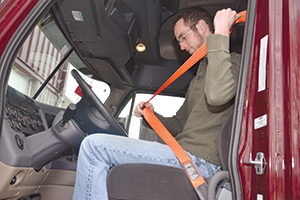Seat Belt Violations Highest During Summer, Data Show

This story appears in the March 16 print edition of Transport Topics.
Citations for failure to use seat belts have a seasonal component — peaking in the summer and falling in the winter, according to a report from data-analysis firm Vigillo.
The Portland, Oregon-based vendor to trucking also said Pennsylvania has been the most aggressive state in issuing tickets to truck drivers for seat belt violations.
Failure to wear a seat belt is a 7-point violation of the unsafe driving category of the federal Compliance, Safety, Accountability program.
The Vigillo report, released March 6, looked at CSA violations from the start of 2013 through the end of 2014.
During that time, Pennsylvania issued more than 10,000 seat belt tickets to truck drivers. No other state topped 6,000.
Vigillo CEO Steve Bryan attributed the result to Pennsylvania receiving a large grant to run a “Click It or Ticket” enforcement campaign.
Trooper Adam Reed, a spokes-man for the Pennsylvania State Police in Harrisburg, said the state has been running a substantial seat belt campaign aimed at passenger cars and commercial trucks, funded in part with grant money from the National Highway Traffic Safety Administration.
As for seasonality, two national peak periods were July through August 2013, with more than 6,000 violations per month; and May to September 2014, with more than 5,000 violations per month.
The low point Vigillo found was December 2013 through February 2014, with about 3,000 violations written per month.
Bryan said most of the violations were issued during roadside inspections where vehicles suspected of having maintenance problems were pulled over by law enforcement. Other citations were issued during inspections at fixed sites, such as weigh stations.
In general, large public inspection campaigns happen during the summer while training for safety inspectors occurs during winter months, said Stephen Keppler, executive director of the Commercial Vehicle Safety Alliance.
CVSA represents North American truck and bus safety inspectors working for law enforcement agencies.
Pennsylvania’s Reed added that it would be extremely difficult to mount an inspection campaign during a winter such as the one now coming to an end. When plowed snow fills up highway shoulders, he said, there is no safe place to pull over a truck.
Keppler said CVSA members view seat belt usage as a critical issue, and a federal report released March 6 provided data.
The Centers for Disease Control and Prevention said motor vehicle crashes were the leading cause of occupational fatalities in the nation in 2012, accounting for 25% of such deaths, with truckers paying a heavy price.
“Truck drivers accounted for 46% of these deaths,” CDC said. “This study estimates the prevalence of seat belt use and identifies factors associated with nonuse of seat belts among longhaul truck drivers, a group of workers at high risk for fatalities resulting from truck crashes.”

